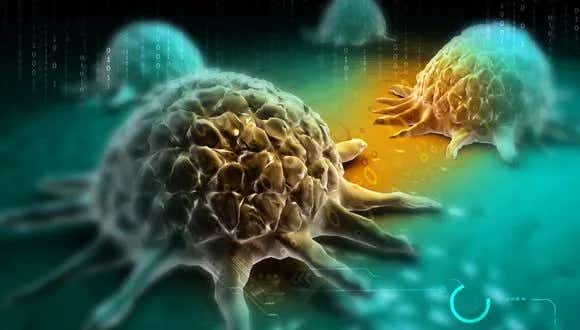First-ever therapy targets and eliminates cancer cells with impressive results
In a medical breakthrough, researchers at Tel Aviv University have harnessed the power of bacterial toxins in the fight against cancer.

[Aug 4, 2023: Staff Writer, The Brighter Side of News]
For the first time in the world: researchers at Tel Aviv University encoded a toxin produced by bacteria into mRNA (messenger RNA) molecules and delivered these particles directly to cancer cells, causing the cells to produce the toxin – which eventually killed them with a success rate of 50%. (CREDIT: Creative Commons)
In an unprecedented medical breakthrough, researchers at Tel Aviv University have harnessed the power of bacterial toxins in the fight against cancer, achieving a success rate of 50%. By encoding a bacterial toxin into messenger RNA (mRNA) molecules and delivering these particles directly to cancer cells, the team has presented an innovative approach to combating the deadly disease.
"Our idea was to deliver safe mRNA molecules encoded for a bacterial toxin directly to the cancer cells – inducing these cells to actually produce the toxic protein that would later kill them. It's like placing a Trojan horse inside the cancer cell." says Prof. Dan Peer, a guiding figure in the world of RNA therapeutics.
It's a method that's as cunning as it sounds: using the cancer cell's own machinery to turn it against itself. The tactic draws its name from the ancient story of the Trojan War where Greeks, unable to conquer the city of Troy, hid in a wooden horse to infiltrate and seize the city. Similarly, the mRNA particles infiltrate the cancer cell, prompting it to produce a toxin that, ultimately, leads to its demise.
Behind the Revolutionary Study
The research, a marvel in the field of oncology, was steered by PhD student Yasmin Granot-Matok and the eminent Prof. Dan Peer, not only the pioneer in the development of RNA therapeutics but also the Head of the Nanomedicine Laboratory at The Shmunis School of Biomedicine and Cancer Research at TAU. Peer wears multiple hats, also serving as TAU's VP R&D.
Related Stories
"Many bacteria secrete toxins. The most famous of these is probably the botulinum toxin injected in Botox treatments. Another classic treatment technique is chemotherapy, involving the delivery of small molecules through the bloodstream to effectively kill cancer cells. However, chemotherapy has a major downside: it is not selective, and also kills healthy cells," Peer explains, highlighting the innovation behind their approach.
To harness the power of bacterial toxins, the team began by encoding the genetic information of a toxic protein from pseudomonas family bacteria into mRNA molecules. For context, this is reminiscent of the procedure where the genetic information of the COVID-19 'spike' protein was encoded into mRNA molecules, leading to the revolutionary vaccine.
These mRNA molecules were then packaged meticulously within lipid nanoparticles, designed in Prof. Peer's laboratory, and subsequently coated with antibodies. This ensured that these toxin instructions precisely targeted the cancer cells.
When tested on animal models with melanoma skin cancer, the results were striking. A single injection led to the disappearance of 44-60% of the cancer cells.
Prof. Dan Peer (CREDIT: Tel Aviv University)
"With a simple injection to the tumor bed, we can cause cancer cells to 'commit suicide', without damaging healthy cells. Moreover, cancer cells cannot develop resistance to our technology as often happens with chemotherapy – because we can always use a different natural toxin," asserts Prof. Peer.
The Broad Potential of the Technique
While the study focused on pseudomonas bacteria and melanoma cancer, Prof. Peer emphasizes that the choice was more about convenience than specificity. Numerous anaerobic bacteria, particularly those found in the ground, secrete toxins. Most of these toxins are potential candidates for their method.
Messenger RNA carries genetic information from DNA in the highly protected nucleus out to the rest of the cell, where structures called ribosomes can build proteins according to the DNA blueprint. (CREDIT: Getty Images Plus)
"When the cancer cell reads the 'recipe' at the other end, it starts to produce the toxin as if it were the bacteria itself. This self-produced toxin eventually kills it," Prof. Peer elaborates.
Key Contributors and Funding
The study was not a solitary effort. Alongside Peer and Granot-Matok, the research team comprised Dr. Assaf Ezra, Dr. Srinivas Ramishetti, Dr. Preeti Sharma, Dr. Gonna Somu Naidu, and Prof. Itai Benhar, the Head of the Antibody Engineering Lab at the Shmunis School of Biomedicine and Cancer Research at TAU. Funding was generously provided by the Shmunis Family Foundation for Biomedicine and Cancer Research.
As the medical community races to find ever more effective treatments against cancer, this "Trojan horse" strategy opens up an exciting new frontier. In merging the age-old tales of subterfuge with cutting-edge science, the team at Tel Aviv University offers hope and a promise of a brighter future in cancer therapeutics.
For more science news stories check out our New Innovations section at The Brighter Side of News.
Note: Materials provided above by the The Brighter Side of News. Content may be edited for style and length.
Like these kind of feel good stories? Get the Brighter Side of News' newsletter.
Joseph Shavit
Head Science News Writer | Communicating Innovation & Discovery
Based in Los Angeles, Joseph Shavit is an accomplished science journalist, head science news writer and co-founder at The Brighter Side of News, where he translates cutting-edge discoveries into compelling stories for a broad audience. With a strong background spanning science, business, product management, media leadership, and entrepreneurship, Joseph brings a unique perspective to science communication. His expertise allows him to uncover the intersection of technological advancements and market potential, shedding light on how groundbreaking research evolves into transformative products and industries.



